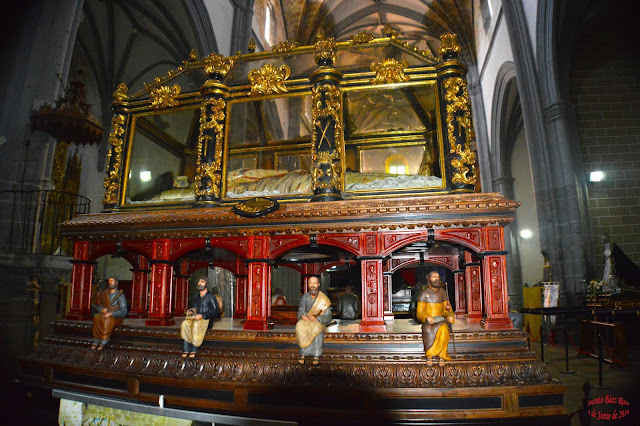 |
La Iglesia de Santo Domingo está situada en la ciudad de Plasencia y anexa al Convento de Santo Domingo del que formaba parte hasta que el convento dejó de realizar las funciones como tal.
La iglesia del convento sigue el trazado de planta de cruz latina con capillas laterales en la nave única. Estas capillas sirvieron de mausoleo para las familias nobles placentinas. El forjado superior es abovedado, con diferentes soluciones arquitectónicas para cada tramo. Siendo el más habitual de de nervios rectos y curvos que se van cruzando. Posee un notabilísimo retablo mayor de estilo manierista, datado en el siglo XVI. Cabe destacar también el altar de azulejos talaveranos que se halla en la sacristía y que es atribuido a Juan de Flores
El templo actualmente no tiene culto y es propiedad de la Caja de Extremadura, quien lo adquirió para que fuera sede de su coleccíon de pintura. No obstante, al ser uno de los mayores templos de la ciudad en la actualidad (2007) sirve como lugar de concentración y exposición de los pasos pocesionales de la Semana Santa placentina. Las diferentes cofradías de la ciudad pretenden que el templo se mantenga con ese fin y convertirlo en Museo de la Semana Santa en Plasencia.
|
 | |||||
The Church of Santo Domingo is located in the city of Plasencia and attached to the Convent of Santo Domingo which included until the convent ceased to perform the functions as such.
The convent church follows the route of a Latin cross with side chapels in the nave. These chapels served as a mausoleum for the noble families placentinas. The upper floor is vaulted, with different architectural solutions for each section. The most common being straight and curved ribs that are crossing. It has a very remarkable Mannerist altarpiece dating from the sixteenth century. Also noteworthy is the altar of Talavera tiles is in the sacristy and is attributed to Juan de Flores
The temple currently has no religion and is owned by the Caja de Extremadura, who acquired it for his collection was based paint. However, being one of the largest temples in the city currently (2007) serves as a place of concentration and exposure pocesionales steps of Holy Week placentina. The different brotherhoods of the city claim that the temple is maintained for that purpose and turn it into Museum of Holy Week in Plasencia.
 | |||||
Die Kirche von Santo Domingo befindet sich in der Stadt von Plasencia und zum Kloster von Santo Domingo angebracht, die eingeschlossen, bis das Kloster, die Funktionen als solche auszuführen aufhörte.
Die Klosterkirche folgt der Route eines lateinischen Kreuzes mit Seitenkapellen im Schiff. Diese Kapellen als Mausoleum für den Adelsfamilien placentinas serviert. Die obere Etage ist gewölbt, mit verschiedenen architektonischen Lösungen für jeden Abschnitt. Die am häufigsten verwendeten geraden und gebogenen sind Rippen, die überquert werden. Es hat eine sehr bemerkenswerte manieristischen Altarbild aus dem sechzehnten Jahrhundert. Bemerkenswert ist auch der Altar von Talavera Fliesen in der Sakristei und an Juan de Flores zugeschrieben
Der Tempel hat derzeit keine Religion und wird von der Caja de Extremadura im Besitz, der sie für seine Sammlung erworben wurde Lack. Allerdings ist einer der größten Tempel in der Stadt zur Zeit (2007) dient als Ort der Konzentration und der Exposition pocesionales Schritte der Karwoche placentina. Die verschiedenen Bruderschaften der Stadt behaupten, dass der Tempel zu diesem Zweck gehalten wird und es in Museum der Karwoche in Plasencia.
 | |||||
L'église de Santo Domingo est situé dans la ville de Plasencia et attaché au couvent de Santo Domingo qui comprenait jusqu'à ce que le couvent a cessé d'exercer les fonctions en tant que telle.
L'église du couvent suit le tracé d'une croix latine avec des chapelles latérales de la nef. Ces chapelles ont servi de mausolée pour les familles nobles placentinas. L'étage supérieur est voûté, avec différentes solutions architecturales pour chaque section. Les étant droites et courbes nervures les plus courants qui traversent. Il a un retable maniériste remarquable datant du XVIe siècle. Il faut également noter l'autel de tuiles Talavera est dans la sacristie et est attribuée à Juan de Flores
Le temple n'a actuellement aucune religion et est possédée par la Caja de Extremadura, qui a acquis pour sa collection a été fondée peinture. Cependant, étant l'un des plus grands temples de la ville actuellement (2007) sert de lieu de concentration et l'exposition pocesionales étapes de la Semaine Sainte placentina. Les différentes confréries de la ville affirment que le temple est maintenu à cette fin et le transformer en Musée de la Semaine Sainte à Plasencia.














No hay comentarios:
Publicar un comentario